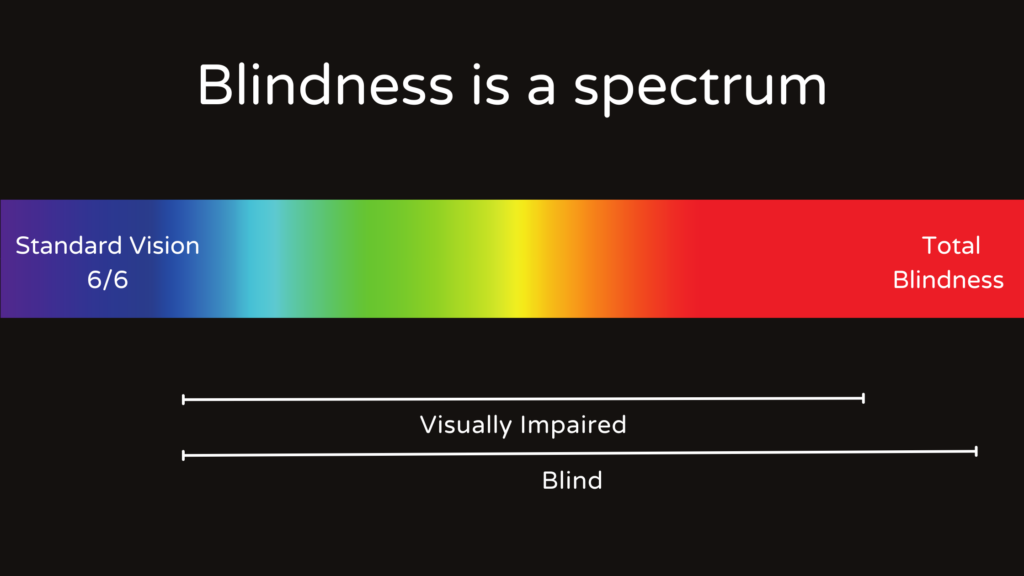When it comes to blindness, there’s a common misconception – that all blind individuals see absolutely nothing.
But this is not the case, blindness is a spectrum. In fact, people living with sight loss often struggle to answer the question, ‘How much can you see?’ And even though doctors have ways to measure visual acuity, it’s hard for anyone to describe what their level of sight is and how they perceive the world around them.
This is because blindness is not a one-size-fits-all condition; it exists on a spectrum. Just as two sighted people may see one shade of blue in different ways, every person experiencing visual impairment will see the world differently.
If you know someone affected by sight loss, it’s important to be aware of this spectrum and to get to know how your friend or loved one sees things. When you know what they are able to see and what’s challenging for them, you’ll be able to support them and be more effective when you help them with specific tasks or activities.
The Spectrum
Blindness is a broad term that encompasses a range of visual impairments. At one end of the spectrum are individuals who have no light perception, known as ‘total blindness.’ This means they cannot detect any light, shape, or colour. On the other end of the spectrum are people who may have just a little less than 6/6 vision. However, the majority of blind individuals fall somewhere along the spectrum, experiencing varying degrees of vision loss.
Low Vision
Many have some residual vision, which is often referred to as ‘low vision’. This means that they can perceive light, shapes, or contrasting colors to varying degrees. Some navigate with a cane or a guide dog, while others don’t need any mobility assistance at all. Some may be able to read large print with the aid of magnification devices, while others may rely on screen readers or Braille.
Colour Blindness
Individuals with visual impairments, such as colour blindness or colour vision deficiency (CVD), can see shapes and objects but have difficulty distinguishing between certain colours. This condition can vary in severity, and there are several types of colour blindness including the inability to detect the colours red, green, or blue. Someone with complete achromatopsia cannot see any colours at all; they see only black, white, and shades of grey.
You can find out more about Colour Blindness from the NIH National Eye Institute.
Tunnel Vision
Tunnel vision is another example of blindness. Individuals with this condition have a restricted field of vision, often seeing only what’s directly in front of them. This can result from conditions like glaucoma, retinitis pigmentosa, optic neuritis, and diabetic retinopathy.
Blind Spots
Blind spots could include the loss of central vision, appearing black spots, and blurriness in areas of the visual field. Again, this can occur with various eye conditions like glaucoma, macular degeneration, eye-related diabetes complications, retina injuries, and others.
Night Blindness
Night blindness, or nyctalopia, is characterised by difficulty seeing in low-light conditions. People with night blindness may have adequate vision during the day but struggle to navigate in dimly lit environments.
Legal Blindness
A term you may have heard is ‘legal blindness.’ This refers to a specific level of vision loss that, while not total, is severe enough to qualify for certain benefits and accommodations. People can register as Sight Impaired (partially sighted) if their vision acuity is between 3/60 – 6/60 and with reduced field of vision. They can register as Severely Sight Impaired (blind) if their vision acuity is less than 3/60 or with a very reduced field of vision.
There’s Support for Everyone
No matter what kind of vision it may be, there’s support for anyone affected by sight loss. Browse our resources to learn about local and national charities for the blind and visually impaired.
Help for People With Sight Loss in England
Charities Supporting Blind and Partially Sighted People in Northern Ireland
Organisations Supporting Blind and Partially Sighted People in Scotland
Organisations Supporting Blind and Partially Sighted people in Wales
Get Help
If you or someone you know is experiencing vision loss, you can take steps to get help with registration. The first step is to get a referral for an eye specialist. You can visit your GP or an optician to get a checkup and a referral to an ophthalmologist. The ophthalmologist will be the one to give you a full assessment and decide if you meet the criteria to be certified. Finally, you can register with your local social services.
There are advantages to registering; you will be able to get support to help you deal with sight loss and keep your independence. You may also qualify to receive concessions that can help you with expenses.
The RNIB is a great source of information. Here are two links that may be helpful if you’re looking to find out more about vision acuity and registering. They can also help you get the process started when you call them on their helpline.
The Criteria for Certification
References
Color Blindness (2023) National Eye Institute. Available at: https://www.nei.nih.gov/learn-about-eye-health/eye-conditions-and-diseases/color-blindness (Accessed: 12 September 2023).
The criteria for Certification (2023) RNIB. Available at: https://www.rnib.org.uk/your-eyes/navigating-sight-loss/registering-as-sight-impaired/the-criteria-for-certification/ (Accessed: 12 September 2023).
Nunez, K. (2021) 7 Possible Causes of Tunnel Vision and What to Do Next, Healthline. Available at: https://www.healthline.com/health/tunnel-vision (Accessed: 12 September 2023).
Professional (2023) What is a Scotoma?, Cleveland Clinic. Available at: https://my.clevelandclinic.org/health/diseases/24687-scotoma (Accessed: 12 September 2023).
Registering as Sight Impaired (2023) RNIB. Available at: https://www.rnib.org.uk/your-eyes/navigating-sight-loss/registering-as-sight-impaired/ (Accessed: 12 September 2023).
By Guenivir Kendrick




